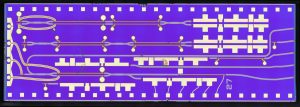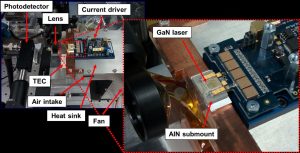In addition to enhancing space exploration, space optical communications can deliver broadband connectivity to remote locations and can assist in disaster recovery. Integrated photonics is an ideal technology for deploying high-performance, space-qualified, and low cost, size, weight and power (CSWaP) photonic systems into space. Photonic integrated circuits (PICs) can be deployed on small spacecraft (ex. cubesats) to enable more frequent and lower cost missions. For space optical communications, our group has been developing integrated photonic laser transmitters, high-power chip-based optical amplifiers, and photonic interposer technologies. We have been pursuing 1550-nm, 9XX-nm, and 4XX-nm wavelength technologies.



Selected Relevant Publications:
- “Integrated transmitter for deep space optical communications,” IEEE Avionics and Vehicle Fiber-Optics and Photonics Conference (AVFOP), 2016.
- “Integrated Indium Phosphide Pulse Position Modulation Transmitter for Free Space Communications,” Integrated Photonics Research, Silicon and Nanophotonics Conference (IPR), paper ITu2A.3, 2016.
- “RZ-DPSK photonic integrated transmitter for space optical communications,” SPIE Photonics West, paper 10524-34, 2018.
- “High-output saturation power variable confinement slab-coupled optical waveguide amplifier,” Optical Fiber Communication Conference (OFC), 2011.
- “High-Power Integrated Indium Phosphide Transmitter for Free Space Optical Communications,” submitted to Conference on Lasers and Electro-Optics (CLEO), 2018.
- “Direct Pulse Position Modulation of a 410 nm Semipolar GaN Laser Diode for Space Optical Communications,” submitted to Conference on Lasers and Electro-Optics (CLEO), 2018.
Collaborators: NASA, SSLEEC, Freedom Photonics, MIT Lincoln Laboratory, Jet Propulsion Laboratory